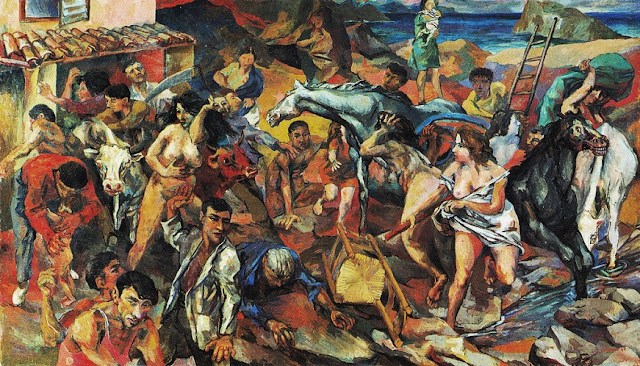Renato Guttuso (26 December 1912 – 18 January 1987) was an Italian painter. His best-known works include Flight from Etna (1938–39), Crucifixion (1941) and La Vucciria (1974). Guttuso also designed for the theatre (including sets and costumes for Histoire du Soldat, Rome, 1940) and did illustrations for books. Those for Elizabeth David’s Italian Food (1954),introduced him to many in the English-speaking world. A fierce anti-Fascist, "he developed out of Expressionism and the harsh light of his native land to paint landscapes and social commentary."


In 1950, Guttuso joined the project of the Verzocchi collection (in the civic Pinacoteca of Forlì), sending, a self-portrait, and the work "Sicilian labourer". He succeeded in astonishing his audience, alternating between the luminous and full vision of colour of "Bagheria on the Gulf of Palermo" to the "Battle of the Bridge of the Admiral", in which he depicted his grandfather Ciro as a Garibaldine soldier. He painted also a series from live about the fights of peasants for the occupation of lands, the zolfatari, or glimpses of landscape between cactus and prickly pears, as well as portraits of men of culture like Nino Garajo and Bruno Caruso.




Fascinated by Dante's model, in 1961 he made a series of colour drawings, published in 1970, as Il Dante di Guttuso, depicting the characters of Hell as examples of human history, confirming the versatility of his talent. In the late 1960s and 1970s he completed a suite of paintings devoted to the feminine figure, a motif that became as dominant in his painting as it was in his life: "Donne stanze paesaggi, oggetti" (1967) was followed by a series of portraits of Marta Marzotto, his preferred muse of many years. His most famous "palermitano" painting is the "Vucciria" (the name of Palermo's market), in which, with raw and bloody realism, he expressed one of the many spirits of the Sicilian city.


Mimise Dotti-Guttuso died on 6 October 1986. Guttuso was soon to follow his wife. He died in Rome of lung cancer at the age of 75 on 18 January 1987. On his deathbed, he allegedly embraced again the Christian faith with which he had been critical. However, there are doubts as to what really happened — in his last months, when he was bedridden, a circle of politicians and priests excluded his oldest friends from his villa. He donated many of his works to his hometown Bagheria, which are now housed in the museum of the Villa Cattolica.Wikipedia





























































